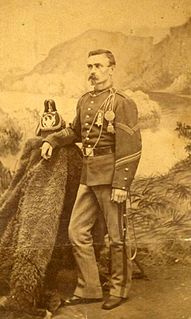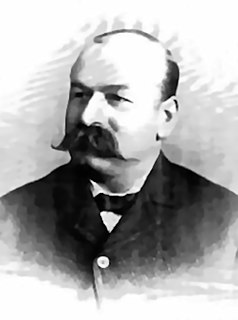Related Research Articles

Henry Johnson was a Buffalo Soldier in the United States Army and a recipient of America's highest military decoration—the Medal of Honor—for his actions in the Indian Wars of the western United States.

Isaiah Mays was a Buffalo Soldier in the United States Army and a recipient of America's highest military decoration—the Medal of Honor—for his actions during the Wham Paymaster Robbery in Arizona Territory.
John D. Kelly was a United States Army soldier and a recipient of the United States military's highest decoration—the Medal of Honor—for his actions in World War II.

Michael B. Ellis was a United States Army sergeant and a recipient of the United States military's highest decoration, the Medal of Honor, for his actions in World War I.

The site of Fort Dodge in the U.S. state of Kansas was originally an old campground for wagons traveling along the Santa Fe Trail, just west of the western junction of the Wet and Dry Routes and near the middle or Cimarron Cutoff. On March 23, 1865, Major General Grenville M. Dodge, who commanded the 11th and 16th Kansas Cavalry Regiments, wrote to Colonel James Hobart Ford to propose establishing a new military post west of Fort Larned. On orders of Col. Ford, Captain Henry Pearce, with Company C, Eleventh Cavalry Regiment, and Company F, Second U.S. Volunteer Infantry, from Fort Larned, occupied and established Fort Dodge on April 10, 1865.
Franklin M. McDonald (1850–unknown) was a soldier in the U.S. Army during the Indian Wars and a recipient of the Medal of Honor for gallantry in defeating Indians who attacked the mail.

John W. Comfort was an American soldier in the U.S. Army who fought during the American Civil War and the Indian Wars from 1861 until his retirement in 1892. He was a member of the 4th U.S. Cavalry during the Texas–Indian Wars and, while battling the Kiowa and Comanche in the Staked Plains in November 1874, killed an Indian in armed combat. He was one of several soldiers cited for bravery in this battle and received the Medal of Honor the following year.
Wilbur Nelson Taylor was an American soldier in the U.S. Army who served with the 8th U.S. Cavalry during the Indian Wars. He was one of eight men who received the Medal of Honor for "bravery in scouts and actions with indians" while fighting the Apache in the Arizona Territory during 1868 and 1869.
Ernest Veuve, born George Ernest Veuve, was a Swiss-born soldier in the U.S. Army who fought during the American Civil War and the Indian Wars as a member of the 16th U.S. Infantry, 3rd U.S. Infantry and 4th U.S. Cavalry. He was cited for bravery while battling the Kiowa and Comanche in the Staked Plains in November 1874, and fought an Indian in hand-to-hand combat for which he received the Medal of Honor.
Frederick S. Neilon, also called Frank Singleton, was an American soldier in the U.S. Army who served with the 6th U.S. Cavalry during the Red River War. He received the Medal of Honor for gallantry fighting Indians at the Upper Washita River on September 9–11, 1874.
Solon D. Neal was an American soldier in the U.S. Army who served with the 6th U.S. Cavalry during the Texas-Indian Wars. He was one of thirteen men who received the Medal of Honor for gallantry against the Kiowa and Chief Kicking Bird at the Battle of the Little Wichita River on July 12, 1870.

Sergeant James Fegan was an American soldier in the U.S. Army who served with the 2nd and 3rd U.S. Infantry during the American Civil War, and Indian Wars. In March 1868, while escorting a powder train en route from Fort Harker to Fort Dodge, Kansas, he single-handedly prevented a mob from blowing up the train to free an army deserter. For his efforts, he received the Medal of Honor.
Sergeant William Foster was a British-born soldier in the U.S. Army who served with the 4th U.S. Cavalry during the Texas–Indian Wars. He received the Medal of Honor for gallantry against the Comanche Indians at the Red River in Texas on September 29, 1872.
Sergeant John P. Schnitzer was an American soldier and wagoner in the U.S. Army who served with both the 23rd U.S. Infantry and 6th U.S. Cavalry in the New Mexico Territory during the Apache Wars. He was awarded the Medal of Honor, along with First Lieutenant Wilber Wilder, for rescuing a fellow soldier under heavy fire while fighting the Apache at Horseshoe Canyon on April 23, 1882, which he received fourteen years later.
Sergeant Julius Alexis Schou was an American soldier in the U.S. Army who served with the 22nd U.S. Infantry during the Sioux Wars. During the Great Sioux War of 1876, Schou risked his life volunteering to carry dispatches from commanders in the field to Fort Buford. He was eventually recognized for his efforts and received the Medal of Honor on November 19, 1884.
Second Lieutenant Jesse T. Barrick was an American soldier who fought in the American Civil War. Barrick was awarded the country's highest award for bravery during combat, the Medal of Honor, for his action along the Duck River in Tennessee between May 26 and June 2, 1863. He was honored with the award on March 3, 1917.

William L. Graul was a Union Army soldier in the American Civil War who received the U.S. military's highest decoration, the Medal of Honor.

Corporal Thomas Parker was a Union Army soldier of the 2nd Rhode Island Infantry who received the Medal of Honor for heroism during the American Civil War.
John G. Miller was an American soldier who fought with the Union Army in the American Civil War. Miller received his country's highest award for bravery during combat, the Medal of Honor, for actions taken on July 3, 1863 during the Battle of Gettysburg.
John S. Shellenberger was a corporal in the United States Army who was awarded the Presidential Medal of Honor for gallantry during the American Civil War. He was awarded the medal on 6 April 1865 for actions performed at the Battle of Deep Run in Virginia on 16 August 1864.
References
- ↑ "Leander T. "Lee" Herron (1846-1937) - Find A Grave Memorial". Find a Grave .
- ↑ "The Tombstone News".
- ↑ "Medal of Honor Recipient Caught Straggling on the March". 10 February 2011.
- ↑ "Medal of Honor Recipient Caught Straggling on the March". 10 February 2011.
- ↑ "Medal of Honor Recipient Caught Straggling on the March". 10 February 2011.
- ↑ "Archived copy" (PDF). Archived from the original (PDF) on 2016-08-20. Retrieved 2016-07-18.
{{cite web}}: CS1 maint: archived copy as title (link) - ↑ "Leander T. "Lee" Herron (1846-1937) - Find A Grave Memorial". Find a Grave .
- ↑ "Indian War Campaigns Medal of Honor Recipients for the United States Army".